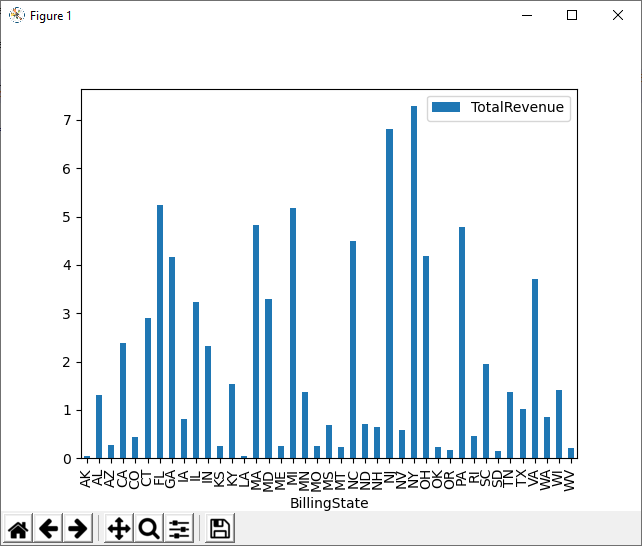Model Context Protocol (MCP) finally gives AI models a way to access the business data needed to make them really useful at work. CData MCP Servers have the depth and performance to make sure AI has access to all of the answers.
Try them now for free →How to Visualize SAP Ariba Source Data in Python with pandas
Use pandas and other modules to analyze and visualize live SAP Ariba Source data in Python.
The rich ecosystem of Python modules lets you get to work quickly and integrate your systems more effectively. With the CData Python Connector for SAP Ariba Source, the pandas & Matplotlib modules, and the SQLAlchemy toolkit, you can build SAP Ariba Source-connected Python applications and scripts for visualizing SAP Ariba Source data. This article shows how to use the pandas, SQLAlchemy, and Matplotlib built-in functions to connect to SAP Ariba Source data, execute queries, and visualize the results.
With built-in optimized data processing, the CData Python Connector offers unmatched performance for interacting with live SAP Ariba Source data in Python. When you issue complex SQL queries from SAP Ariba Source, the driver pushes supported SQL operations, like filters and aggregations, directly to SAP Ariba Source and utilizes the embedded SQL engine to process unsupported operations client-side (often SQL functions and JOIN operations).
Connecting to SAP Ariba Source Data
Connecting to SAP Ariba Source data looks just like connecting to any relational data source. Create a connection string using the required connection properties. For this article, you will pass the connection string as a parameter to the create_engine function.
In order to connect with SAP Ariba Source, set the following:
- API: Specify which API you would like the provider to retrieve SAP Ariba data from. Select the Supplier, Sourcing Project Management, or Contract API based on your business role (possible values are SupplierDataAPIWithPaginationV4, SourcingProjectManagementAPIV2, or ContractAPIV1).
- DataCenter: The data center where your account's data is hosted.
- Realm: The name of the site you want to access.
- Environment: Indicate whether you are connecting to a test or production environment (possible values are TEST or PRODUCTION).
If you are connecting to the Supplier Data API or the Contract API, additionally set the following:
- User: Id of the user on whose behalf API calls are invoked.
- PasswordAdapter: The password associated with the authenticating User.
If you're connecting to the Supplier API, set ProjectId to the Id of the sourcing project you want to retrieve data from.
Authenticating with OAuth
After setting connection properties, you need to configure OAuth connectivity to authenticate.
- Set AuthScheme to OAuthClient.
- Register an application with the service to obtain the APIKey, OAuthClientId and OAuthClientSecret.
For more information on creating an OAuth application, refer to the Help documentation.
Automatic OAuth
After setting the following, you are ready to connect:
-
APIKey: The Application key in your app settings.
OAuthClientId: The OAuth Client Id in your app settings.
OAuthClientSecret: The OAuth Secret in your app settings.
When you connect, the provider automatically completes the OAuth process:
- The provider obtains an access token from SAP Ariba and uses it to request data.
- The provider refreshes the access token automatically when it expires.
- The OAuth values are saved in memory relative to the location specified in OAuthSettingsLocation.
Follow the procedure below to install the required modules and start accessing SAP Ariba Source through Python objects.
Install Required Modules
Use the pip utility to install the pandas & Matplotlib modules and the SQLAlchemy toolkit:
pip install pandas pip install matplotlib pip install sqlalchemy
Be sure to import the module with the following:
import pandas import matplotlib.pyplot as plt from sqlalchemy import create_engine
Visualize SAP Ariba Source Data in Python
You can now connect with a connection string. Use the create_engine function to create an Engine for working with SAP Ariba Source data.
engine = create_engine("saparibasource:///?API=SupplierDataAPIWithPagination-V4&APIKey=wWVLn7WTAXrIRMAzZ6VnuEj7Ekot5jnU&Environment=SANDBOX&Realm=testRealm&AuthScheme=OAuthClient&InitiateOAuth=GETANDREFRESH&OAuthSettingsLocation=/PATH/TO/OAuthSettings.txt")
Execute SQL to SAP Ariba Source
Use the read_sql function from pandas to execute any SQL statement and store the resultset in a DataFrame.
df = pandas.read_sql("SELECT SMVendorID, Category FROM Vendors WHERE Region = 'USA'", engine)
Visualize SAP Ariba Source Data
With the query results stored in a DataFrame, use the plot function to build a chart to display the SAP Ariba Source data. The show method displays the chart in a new window.
df.plot(kind="bar", x="SMVendorID", y="Category") plt.show()

Free Trial & More Information
Download a free, 30-day trial of the CData Python Connector for SAP Ariba Source to start building Python apps and scripts with connectivity to SAP Ariba Source data. Reach out to our Support Team if you have any questions.
Full Source Code
import pandas
import matplotlib.pyplot as plt
from sqlalchemy import create_engin
engine = create_engine("saparibasource:///?API=SupplierDataAPIWithPagination-V4&APIKey=wWVLn7WTAXrIRMAzZ6VnuEj7Ekot5jnU&Environment=SANDBOX&Realm=testRealm&AuthScheme=OAuthClient&InitiateOAuth=GETANDREFRESH&OAuthSettingsLocation=/PATH/TO/OAuthSettings.txt")
df = pandas.read_sql("SELECT SMVendorID, Category FROM Vendors WHERE Region = 'USA'", engine)
df.plot(kind="bar", x="SMVendorID", y="Category")
plt.show()

